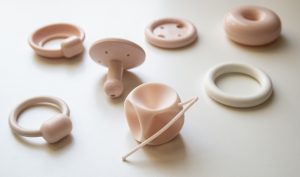Emi Bretschneider, MD
Pessary_FFHA2019
Pelvic organ prolapse or vaginal prolapse and urinary incontinence are medical problems that women of any age can have, but are more common for older women. Pelvic organ prolapse, also known as vaginal prolapse, is a condition where women feel a bulge in their vaginal area because her uterus (or womb) or walls of the vagina have weakened and lost support. Women are bothered by the bulge they feel or by losing control of their urine. While there are many ways to treat a bulge in the vagina and leaking of urine, using a device called a pessary is one of the easiest ways to treat these problems.

What is a pessary?
Simply, a pessary is small, flexible plastic device that you place in your vagina. The pessary holds the vaginal bulge in place so that you can no longer feel the bulge. Your provider might show you how to put in and replace the pessary yourself. If you don’t want to or can’t place the device in your vagina or remove it by yourself, then your medical provider can do it for you. The pessary can be cleaned easily with soap and water. You can leave the pessary in your vagina for up to 3 months at a time without changing. You are not supposed to be able to feel the pessary when it is in your vagina.
What are some benefits of using a pessary?
A pessary can help make the bulge you feel in your vagina go away while the pessary is in place. You do not have to undergo surgery or be put to sleep with anesthesia to have the pessary placed. In other words, you can use the pessary instead of having surgery if your medical provider thinks that the pessary is a good option for you. You can have sex with some types of pessaries available, but not all, so remember to ask your medical provider if you can still have sex with the kind of pessary you are using.
Who would benefit from a pessary?
If you feel a bulge in your vaginal area and are bothered by this feeling, then you can ask your medical provider if you can try a pessary. If you don’t want surgery or can’t have surgery for one reason or another, then your medical provider may recommend a pessary.
How do I get a pessary?
You need to visit a medical provider who knows how to fit patients with pessaries. Not all medical providers know how to treat a patient with a pessary, and you might have to ask your provider to recommend another medical provider who has special training in treating prolapse. You can ask your medical provider if a pessary is right for you, and if they agree that trying a pessary is a good idea, then they will check your prolapse and choose the right pessary for you.
What is it like to wear a pessary?
Once the pessary is in place, you should not feel it at all. Some people compare wearing a pessary to wearing a shoe. You know you’re wearing a pessary, but the pessary should be comfortable. In other words, you should know that you’re using the pessary since the bulge is gone, but you should not feel it when it’s sitting in your vagina. The pessary only works when it’s in your vagina. When you remove the pessary, your bulge will return.
How long can I use a pessary for?
You can use a pessary for years if you like the results and if you don’t have any problems with it.
What kind of problems could I get from a pessary?
Some women notice some more vaginal discharge when they use a pessary. If the discharge becomes bloody or if the discharge smells bad, let your medical provider know.
If your vaginal tissue is thin from menopause, then the pessary might irritate your vagina and you may need to take a break from using the pessary for a while. Your provider may also tell you to use vaginal estrogen cream to help build up the health of your vaginal tissue so that the pessary can sit in the vagina more comfortably.
The pessary might fall out if it’s not the right size. It also could be uncomfortable if it’s too large. Go see a medical provider if you have these problems with your pessary.
Occasionally, some women have problems urinating. Some can’t pee, while some can’t control their urine. Also, some women have problems moving their bowels. If you have any of these problems, make sure you tell your medical provider. Your medical provider may decide to change the pessary or recommend another kind of therapy.
How can I avoid these complications?
Most of the side effects are minor. Making sure you take your pessary out from your vagina regularly if you’re having problems might be all you need to do. Your medical provider may recommend that you use vaginal estrogen cream. If you’re worried about any of these problems, make sure you talk to your medical provider.

Are there different kinds of pessaries?
All pessaries are made from a strong, flexible plastic, but just like shoes, they come in different shapes and sizes. Here are some pictures of some of the most commonly used pessaries.
Ring: This kind of pessary is best for women with mild prolapse.
Ring with support: This kind of pessary is best for women with mild prolapse, which includes bulging of the bladder.
Incontinence pessary: This kind of pessary is best for women with only stress urinary incontinence.
Gelhorn, Donut or Cube pessaries: These kinds of pessary are best for women with more severe prolapse. They need to be taken in and out by a medical provider because of their size and shape.
How do I care for a pessary?
You can either take care of the pessary yourself at home or have your medical provider help you manage it. If you care for the pessary yourself, make sure you clean the pessary with soap and water after you remove it and before you put it back in. If you see your medical provider to care for the pessary, then your medical provider will take the pessary out, clean it and put it back in for you. Before they put the pessary back, they will take a look at your vaginal tissue to make sure that there are not scrapes or skin breakdown. Remember that when the pessary is out, you will be able to feel the bulge.
How do I know that a pessary is working well for me?
If your vaginal bulge disappears when you are wearing the pessary and you have not had any issues which make it difficult for you to wear the pessary, then the pessary is working well for you. You can continue to use the pessary for as long as you feel like you need to use it or for as long as your medical provider recommends.
How do I know that a pessary is not working for me?
If the pessary keeps falling out of your vagina or if you experience side effects that you don’t like, then you should talk to your medical provider about other options.
Take Home Points
- Pessaries are small, flexible plastic devices that you place in your vagina to treat pelvic organ prolapse or urinary incontinence.
- The pessary holds the vaginal bulge in place so that you can no longer feel the bulge.
- If you don’t want surgery or can’t have surgery, then your medical provider may recommend a pessary.
Additional Resources
Author Information

Emi Bretschneider, MD
Assistant Professor, Department of OB-GYN,
Urogynecology & Reconstructive Pelvic Surgery,
Northwestern Medicine, Chicago, IL, USA
No conflicts of interest to report.






